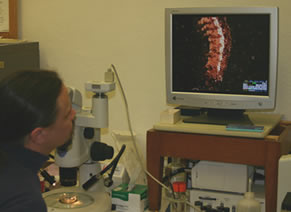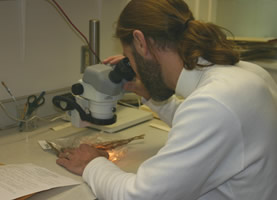|
Don't
go buggy wondering what that insect or plant might be: Ask K-State
By Cheryl
May
Got bugs?
Got bugs on your plants or in your house?
If you can
photograph it or capture it, Kansas State University experts can help
you find out what the insect invader might be.
With plants,
touching it to see if you develop a rash is not the best way to tell if
something growing in your yard is poison ivy. There's a better way to
find out which plant is which -- and it doesn't involve your skin and
buckets of calamine lotion.
K-State offers
both bug and plant identification services free to Kansas residents.
"Most
insects are not harmful, but some insects are, or have the potential of
being harmful in some manner," said Bobby Brown, who runs the entomology
department's Insect Diagnostic Laboratory. He said that in order to control
a pest it is imperative to accurately identify the insect causing the
problem.
"We
must first know what we are dealing with before we can determine how to
deal with it."
The goal
of K-State's Insect Diagnostic Laboratory is to provide a prompt yet accurate
diagnosis of insects and insect related problems. Control methods may
also be provided upon request. The Insect Diagnostic Laboratory can also
provide assistance with identification of non-insect arthropods, such
as spiders, ticks, mites, centipedes, etc. In the photo at right, Brown
looks at a caterpillar on a screen connected to a microscope in the lab.
Brown said
he's seen some unusual specimens come through the lab.
"The
most unusual was a venomous spider from South America," Brown said.
"It arrived in a bunch of bananas shipped to campus. The person who
found the spider just picked it up and brought it in for identification.
It was amazing that no one was bitten or injured -- it was a nasty spider."
Also unusual
were the leeches found in a Kansas farm pond.
Brown said
he enjoys the variety in his job. "Every day is almost like Christmas.
You open a package and you don't know what you'll see."
The most
common pest sent in for identification varies by year.
"Some
years a population explodes and we see a lot of a specific insect,"
Brown said. "We always see a lot of springtails, which are little
jumping insects; and we see many termites from homeowners who want to
verify that's what they've got. We see a lot of ticks of various kinds,
but we rarely get lice and fleas. If someone has an insect question, we
encourage them to send it in. Our services are open and free to people
who are curious about a pest -- they don't need to be noxious or causing
harm."
 For
more than a century, the K-State herbarium has served as a statewide resource
for plant identifications. Mark H. Mayfield, plant identification expert
for K-State's herbarium, advises Kansas residents to submit a sample --
preferably with flowers and/or fruits attached -- to your county extension
agent, or contact the K-State herbarium directly if the county office
cannot be reached. If you think the plant might be poison ivy or poison
oak, try sending a photograph instead. In the photo at left, Mayfield
is shown identifying a sample sent in to the herbarium. For
more than a century, the K-State herbarium has served as a statewide resource
for plant identifications. Mark H. Mayfield, plant identification expert
for K-State's herbarium, advises Kansas residents to submit a sample --
preferably with flowers and/or fruits attached -- to your county extension
agent, or contact the K-State herbarium directly if the county office
cannot be reached. If you think the plant might be poison ivy or poison
oak, try sending a photograph instead. In the photo at left, Mayfield
is shown identifying a sample sent in to the herbarium.
"It
is helpful to record notes regarding where the plant was growing, whether
it was cultivated, and so on," Mayfield said. "Herbarium staff
will report the plant's identity and related information. If the plant
is considered undesirable, the identification will be forwarded to a weed
scientist for recommendations on control."
|
How
to submit insect or plant samples to K-State
The
services of the Insect Diagnostic Laboratory for insect identification,
and those of the herbarium for plant identification, are open to
any Kansas resident through their local county extension office.
In many cases the county extension agent will be able to identify
the insect and provide you with the appropriate management information.
Or they can mail the insects to the Insect Diagnostic Laboratory
for you.
Bobby
Brown, director of the Insect Diagnostic Laboratory, said if you
prefer, you may send a digital photograph by e-mail to gotbugs@k-state.edu,
or a hard copy photo by postal mail.
"Depending
on the insect, getting an image of the top of the insect, especially
the wings is critical," Brown said. "If it's a beetle,
the top is important. If it's a caterpillar, we need to see both
top and bottom views. A lot of caterpillar identification is based
on counting the false legs on the bottom. For a critical identification,
we need to have them sent in. With spiders, we need to get a top
view and a front view to see the pattern of the eyes.
How
to Submit Insect Samples for Identification:
Small
insect specimens should be placed in a vial of alcohol (rubbing
alcohol is adequate) for preservation purposes. Send duplicate specimens,
if they are available.
To
kill large specimens, such as butterflies, place them in a freezer
for 24 hours. Then carefully place the specimen in a crush-proof-box
cushioned with tissue paper. Never send such a sample in cotton
since the legs and antennae get tangled in the cotton and will easily
break. NEVER MAIL LIVE INSECTS -- it is illegal!
Often
it is helpful to submit samples of damage along with the insects.
When submitting plant samples, place them in a mailing canister
or a cardboard box. Plants should be placed in an unsealed bag.
Never place water or moist towels with such a sample. Submit only
representative samples and mail them early in the week to guarantee
the sample will arrive by Friday in good condition. Your county
extension office should be able to supply you with vials and mailing
tubes, if it is necessary to mail the sample to the diagnostic laboratory.
The
information form is another important aspect of any submittal. These
forms should be filled out accurately and thoroughly. Always include
your name, the county and your telephone. It is also very important
to indicate where an insect was found. Many times such information
helps in making an accurate identification. Specific information
regarding the exact location of an insect, i.e. near a drain in
the basement, is also very beneficial. It is also helpful to know
how many insects are occurring. Additional information on collection
sites, insect habits and any other pertinent information is also
beneficial when making identifications.
Photos
of plants may be sent to herbariu@k-state.edu, or mailed to Herbarium,
Division of Biology, Ackert Hall, Kansas State University, Manhattan,
KS 66506-4901.
A directory
of insect information is on the Web at http://www.entomology.ksu.edu/desktopDefault.aspx?tabid=375
Common
plant problems in Kansas: http://www.oznet.ksu.edu/dp_hfrr/extensn/hortprob.htm
|
Winter
2003
|